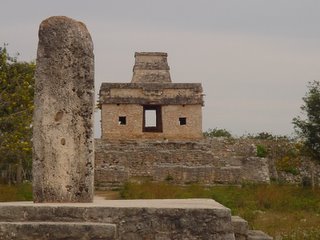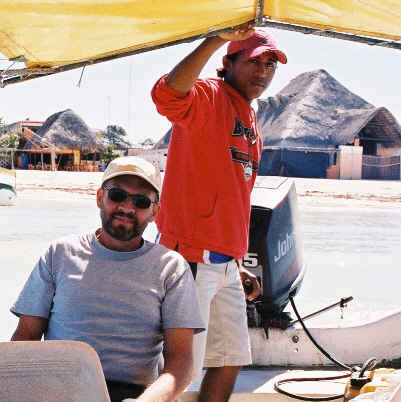 Thursday I took the local bus, for $7 pesos each way, to Dzibilchaltun (the place of writing on stones), a partially restored Mayan city about 10 miles from Merida.
Thursday I took the local bus, for $7 pesos each way, to Dzibilchaltun (the place of writing on stones), a partially restored Mayan city about 10 miles from Merida.Dzibilchaltun was once home to an estimated 40,000 Mayans and covers quite an extensive area. The city’s large main plaza is surrounded by a large number of buildings, many of which are in various states of renovation and flanked by a good sized cenote of clear, blue water in which visitors are welcome to swim. Cenotes are openings in the limestone, of which the Yucatan is composed, in which water is generally perched upon the underlying limestone, creating a pond. Cenotes are often connected to water filled caves that are ubiquitous throughout the Northern Yucatan.
The city’s first constructions date to 500 BC and was inhabited as late as the 17th century as evidenced by the Franciscan chapel constructed about 1600. The Catholic invaders apparently determined there were enough folks living in the city, estimated to be about 4,000 at the time, to warrant construction of a chapel, which has been largely restored. The city covers about 15 square kilometers, contains evidence of over 8,400 buildings, 8000 of which remain unexcavated .
Despite its nearness to Merida and the fact that it was so recently inhabited, the ruins were not “discovered’ until 1941. The vegetation here rapidly consumes anything that is undisturbed for even a short while and the unrenovated buildings in the city consist of piles of stones covered in vegetation, from grasses to trees. Even on the renovated structures plants sprout from even the smallest of cervices between the stones.
Separated from the main plaza by a Sacbe, a raised roadway, perhaps a mile long and 50 yards wide and which looks like a landing strip, is the Temple of the Seven Dolls. The temple has been named such for the seven small sculpted figurines found during the building’s excavation. The temple is oriented such that on the Spring and Fall equinoxes the rising sun shines directly through the building’s openings shown in the picture above. The site opens early on the equinoxes to accommodate the few thousand tourist and local folks who attend to witness the phenomena. Many of the locals dress in white for the occasion.
The site includes the Museum of the Mayan People, a number of interpretive signs, lots of butterflies, and an array of vegetation from succulents to cacti.
The local bus leaves from the Progreso station on Calle 62, the trip takes about an hour with the frequent stops, and there is about a 1 km walk from the bus stop to the site. There are guides at the museum who speak English well and who offer their services; but you know me, I opted for an unaccompanied visit.
I spent about two and a half thoroughly enjoyable hours wandering the site and as soon as I completed my walk back to the main road I hopped on a bus headed for Merida that happened along. More good fortune. I thought I would have to wait about an hour for the next bus and there was no place in the area offering cold beer.
Most of the pictures I took of the site I took with my 35 mm camera as it takes better pictures. As soon as I have the roll developed I will post more pictures of my trip.

No comments:
Post a Comment